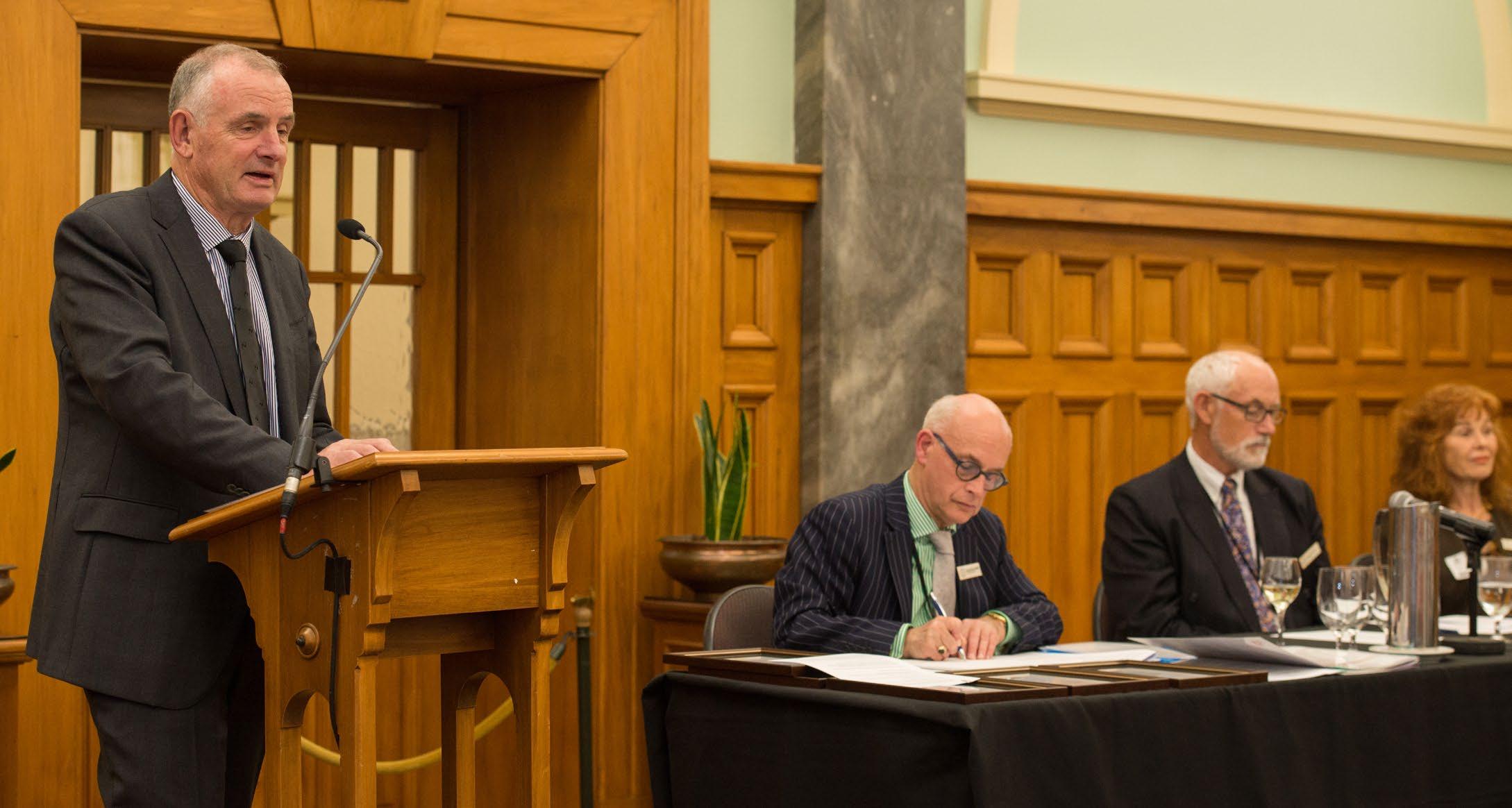
6 minute read
Independent Auditor’s Report
by NZBPT
Audit
Grant Thornton New Zealand Audit Partnership
L15 Grant Thornton House 215 Lambton Quay PO Box 10712 Wellington 6143
T +64 (0) 4 474 8500 F +64 (0) 4 474 8509 www.grantthornton.co.nz
TO THE MEMBERS OF THE NEW ZEALAND BUSINESS & PARLIAMENT TRUST : REPORT ON THE PERFORMANCE REPORT
OPINION
We have audited the performance report of New Zealand Business and Parliament Trust (the “Trust”) on pages 18 to 28, which comprises the entity information, the statement of service performance, the statement of financial performance and statement of cash flows for the year ended 31 December 2019, the statement of financial position as at 31 December 2019, and notes to the financial statements, including summary of significant accounting policies and other explanatory information.
In our opinion:
a) the reported outcomes and outputs, and quantification of the outputs to the extent practicable, in the statement of service performance are suitable;
b) the accompanying performance report presents fairly, in all material respects:
the entity information for the year then ended;
the service performance for the year then ended; and
the financial position of the Trust as at 31 December 2019 and its financial performance, and cash flows for the year then ended
in accordance with Public Benefit Entity Simple Format Reporting – Accrual (Not-ForProfit) issued in New Zealand by the New Zealand Accounting Standards Board.
BASIS FOR OPINION
We conducted our audit of the statement of financial performance, statement of financial position, statement of cash flows, statement of accounting policies and notes to the performance report in accordance with International Standards on Auditing (New Zealand) (ISAs (NZ)), and the audit of the entity information and statement of service performance in accordance with the International Standard on Assurance Engagements (New Zealand) ISAE (NZ) 3000 (Revised).
Our responsibilities under those standards are further described in the Auditor’s Responsibilities for the Audit of the Performance Report section of our report. We are independent of the Trust in accordance with Professional and Ethical Standard 1 (Revised) Code of Ethics for Assurance Practitioners issued by the New Zealand Auditing and Assurance Standards Board, and we have fulfilled our other ethical responsibilities in accordance with these requirements. We believe that the audit evidence we have obtained is sufficient and appropriate to provide a basis for our opinion.
Other than in our capacity as auditor we have no relationship with, or interests in, the Trust.
INDEPENDENT AUDITOR’S REPORT
OTHER INFORMATION
The Trustees are responsible for the other information. The other information comprises the President’s Message, Chairman’s Message and Chief Executive’s Report but does not include the performance report and our auditor’s report thereon.
Our opinion on the performance report does not cover the other information and we do not express any form of audit opinion or assurance conclusion thereon.
In connection with our audit of the performance report, our responsibility is to read the other information and, in doing so, consider whether the other information is materially inconsistent with the performance report or our knowledge obtained in the audit or otherwise appears to be materially misstated. If, based on the work we have performed, we conclude that there is a material misstatement of this other information; we are required to report that fact. We have nothing to report in this regard.
The Trustees are responsible for:
(a) Identifying outcomes and outputs, and quantifying the outputs to the extent practicable, that are relevant, reliable, comparable and understandable, to report in the statement of service performance;
(b) the preparation and fair presentation of the performance report on behalf of the
Trust which comprises:
the entity information;
the statement of service performance; and
the statement of financial performance, statement of financial position, statement of cash flows, statement of accounting policies and notes to the performance report
in accordance with Public Benefit Entity Simple Format Reporting – Accrual (Not-ForProfit) issued in New Zealand by the New Zealand Accounting Standards Board, and
(c) for such internal control as the Trustees determine is necessary to enable the preparation of the performance report that is free from material misstatement, whether due to fraud or error.
In preparing the performance report, the Trustees are responsible on behalf of Trust for assessing the Trust’s ability to continue as a going concern, disclosing, as applicable, matters related to going concern and using the going concern basis of accounting unless the Trustees either intend to liquidate Trust or to cease operations, or have no realistic alternative but to do so.
Our objectives are to obtain reasonable assurance about whether the performance report is free from material misstatement, whether due to fraud or error, and to issue an auditor’s report that includes our opinion. Reasonable assurance is a high level of assurance, but is not a guarantee that an audit conducted in accordance with ISAs (NZ) and ISAE (NZ) will always detect a material misstatement when it exists. Misstatements can arise from fraud or error and are considered material if, individually or in the aggregate, they could reasonably be expected to influence the economic decisions of users taken on the basis of this performance report.
As part of an audit in accordance with ISAs (NZ) and ISAE (NZ) 3000 (Revised), we exercise professional judgement and maintain professional scepticism throughout the audit. We also:
Identify and assess the risks of material misstatement of the financial statements, whether due to fraud or error; to design and perform audit procedures responsive to those risks, and to obtain audit evidence that is sufficient and appropriate to provide a basis for the auditor’s opinion. The risk of not detecting a material misstatement resulting from fraud is higher than for one resulting from error, as fraud may involve collusion, forgery, intentional omissions, misrepresentations, or the override of internal control.
Obtain an understanding of internal control relevant to the audit in order to design audit procedures that are appropriate in the circumstances, but not for the purpose of expressing an opinion on the effectiveness of the entity’s internal control.
Evaluate the appropriateness of accounting policies used and the reasonableness of accounting estimates and related disclosures made by management.
Conclude on the appropriateness of management’s use of the going concern basis of accounting and, based on the audit evidence obtained, whether a material uncertainty exists related to events or conditions that may cast significant doubt on the entity’s ability to continue as a going concern. If the auditor concludes that a material uncertainty exists, the auditor is required to draw attention in the auditor’s report to the related disclosures in the financial statements or, if such disclosures are inadequate, to modify the opinion. The auditor’s conclusions are based on the audit evidence obtained up to the date of the auditor’s report. However, future events or conditions may cause an entity to cease to continue as a going concern.
Evaluate the overall presentation, structure and content of the financial statements, including the disclosures, and whether the financial statements represent the underlying transactions and events in a manner that achieves fair presentation.
Perform procedures to obtain evidence about and evaluate whether the reported outcomes and outputs, and quantification of the outputs to the extent practicable, are relevant, reliable, comparable and understandable.
We communicate with the Trustees regarding, among other matters, the planned scope and timing of the audit and significant audit findings, including any significant deficiencies in internal control that we identify during our audit.
INDEPENDENT AUDITOR’S REPORT
RESTRICTION ON USE OF OUR REPORT
This report is made solely to the Trusts Members as a body.
Our audit work has been undertaken so that we might state to the Trusts Members as a body, those matters which we are required to state to them in our audit report and for no other purpose.
To the fullest extent permitted by law, we do not accept or assume responsibility to anyone other than the Trust and its Members, as a body, for our audit work, for this report or for the opinion we have formed.
Grant Thornton New Zealand Audit Partnership
B Kennerley
Partner
Wellington







